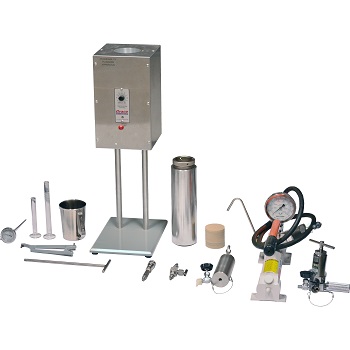Permeability Plugging Apparatus (PPA)
M4100 Permeability Plugging Apparatus (PPA)
- Max Temperature: 500°F (260°C)
- Max Pressure: 5,000 psig (~34,474 kPa)
- Dimensions: 8" W x 11.75" D x 25" H
High-Pressure, High-Temperature Downhole Static Filtration Testing
The Grace Instrument M4100 HPHT Permeability Plugging Apparatus (PPA) simulates downhole static filtration. The M4100 allows researchers to minimize differential sticking by analyzing drilling fluid caking properties and their potential to isolate reservoir depletions or underpressures. The high-pressure, high-temperature M4100 cell included with each unit can be pressurized up to 5,000 psig (~34,474 kPa) at a maximum operating temperature of 500°F (260°C).
Dependable Measurement and Intuitive, Easy-to-Use Operation
A ceramic filter disc is placed on top of the cell. Using a hand pump, pressure is exerted at the bottom. This upward filtration mechanism prevents solids from settling due to gravity, ensuring the most accurate test results are achieved. As pressure continues to be applied, the piston in the cell moves upwards, forcing mud through the filter. A filter cake starts to accumulate on the disc. The airtight piston and O-ring seal inside the cell is engineered to separate hydraulic oil in the bottom of the cell from the mud in the top of the cell, ensuring they never make contact. The M4100 is pressurized using carbon dioxide. Pressurization methods include carbon dioxide cartridges or an in-house (user-provided) carbon dioxide source using backpressure receiver. The maximum pressure for the backpressure receiver is 750 psi. If desired, a nitrogen manifold with in-house (user-provided) nitrogen may be used to pressurize instead. To change the temperature of the heating jacket, which simulates reservoir temperature, simply turn the thermostat knob on the front of the metal plate. The thermostat cover is marked from 1 to 10. Each whole number represents a separate temperature. The temperature of the heating jacket is measured with a dial thermometer and then placed into the cell body. The measured temperature is recorded for future reference.
Overpressure Safety Mechanism
The pressure cell contains rupture discs for operator safety. When the pressure exceeds the maximum, these discs will rupture, releasing pressure until reaching atmospheric pressure.
Customize Filter Media to Formation—Wide Range of Porosities Available
Ceramic filter discs come in a wide range of porosities to match the porosity of your actual formation.
Rugged Stainless-Steel Construction
The M4100 features a stainless-steel construction, making cleanup after tests fast and easy. This rugged device can be used in the field and laboratory.
| Cell Maximum Operating Pressure: 5,000 psig (~34,474 kPa) |
| Maximum Cell Temperature: 500°F (260°C) |
| Maximum Sample Volume: 275 ml |
| Back Pressure Receiver Volume: 100 ml |
| Material: stainless-steel construction |
| Electrical Specifications: 800 W; 50-60 Hz; 110-120V AC or 220-240V AC (not both), check electrical label to see which configuration applies, single-phase |
| Weight: 70 lbs. (32 kg.) |
| Dimensions: 8" W x 11.75" D x 25" H |
- High-pressure, high-temperature downhole static filtration testing.
- Pressurization up to 5,000 psig (~34,474 kPa) at a maximum operating temperature of 500°F (260°C).
- Upward filtration mechanism prevents solids from settling due to gravity, ensuring the most accurate test results are achieved.
- Airtight piston and O-ring seal inside cell separates hydraulic oil from mud on the top of the cell, ensuring they never make contact.
- Pressurized using carbon dioxide, but can use nitrogen with nitrogen manifold (sold separately).
- 750 psi maximum backpressure receiver pressure.
- Operator safety mechanism—cell contains rupture discs that release pressure when max pressure is exceeded.
- Wide range of filter disc porosities available to match your formation.
- Stainless-steel construction, making cleanup after tests fast and easy.
- Intuitive, easy-to-use operation.


